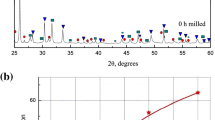Abstract
Transformations from precursors to nanoparticles by high-energy milling are promoted by two major driving forces, namely physical and/or chemical. While the former has been difficult to trace since stress, strain and recovery may occur almost simultaneously during milling, the latter has been sequentially followed as an evolution from precursors to intermediate phases and thereof to high purity nanocrystals. The specific objective of this work is to discern how solid–solid and partially solid–gas reactions manifest themselves correspondingly as a short-range diffusion through an interface or how vapor species, as a subliming phenomenon, grows as a different phase on an active local surface. These series of changes were traced by sub-cooling the as-milled powders extracted during a milling cycle. Through this experimental technique, samples were electron microscopically analyzed and where it was required, selected area electron diffraction images were obtained. High-resolution transmission electron microscopy results, unambiguously, confirm that nanocrystals in the last stage show a cubic morphology which average size distributions are around 17 nm.








Similar content being viewed by others
Abbreviations
- HEM:
-
High-energy milling
- HRTEM:
-
High-resolution transmission electron microscopy
References
Fan GJ, Guo FQ, Hu ZQ et al (1997) Amorphization of selenium induced by high-energy ball milling. Phys Rev B 55(17):11010–11013
Groza JR, Shackelford JF, Lavernia EJ, Powers MT (2007) Materials processing handbook. CRC Press, New York
Gusev AI, Rempel AA (2005) Nanocrystalline materials. Cambridge International Science Publishing, Great Britain
Humphreys FJ, Hatherly M (2004) Recrystallization and related annealing phenomena, 2nd edn. Elsevier, The Netherlands
Kaur A, Khanna A, Pesquera C et al (2010) Preparation and characterization of lead and zinc tellurite glasses. J Non-Cryst Solids 356:864–872
Li H, Cai KF, Yin JL et al (2010) Preparation and growth mechanism of lead telluride nanocrystals by a modified molten composite-hydroxides method. J Nanosci Nanotechnol 10:5831–5837
Machlin ES (2007) An introduction to aspects of thermodynamics and kinetics relevant to materials science. Elsevier, Great Britain
Rojas-Chávez H, Díaz-de la Torre S, Jaramillo-Vigueras D et al (2009) PbTe mechanosynthesis from PbO and Te. J Alloy Compd 483:275–278
Rojas-Chávez H, Reyes-Carmona F, Plascencia G et al (2010) Analysis of nanocrystalline intermetallic compounds from their X-ray diffraction patterns. Mater Sci Forum 644:69–74
Rojas-Chávez H, Reyes-Carmona F, Jaramillo-Vigueras D (2011) Solid-state reactions to synthesize nanostructured lead selenide semiconductor powders by high-energy milling. Mater Res Bull 46:1560–1565
Rojas-Chávez H, Reyes-Carmona F, Achimovičová M et al (2012) PbSe nanocubes obtained by high-energy milling. J Nanopart Res 14(6):897–904
Rojas-Chávez H, Reyes-Carmona F, Huerta L et al (2013) Intermediate surface reactions to obtain nanocrystalline PbTe via high-energy milling. Mater Res Bull 48:1381–1387
Schmalzried H (1974) Solid state reactions. Verlag Chemie GmbH, Germany
Wang YY, Cai KF, Yao X (2009) Facile synthesis of PbTe nanoparticles and thin films in alkaline aqueous solution at room temperature. J Solid State Chem 182:3383–3386
Zhang J, Kumbhar A, He J et al (2008) Simple cubic super crystals containing PbTe nanocubes and their core-shell building blocks. J Am Chem Soc 130:15203–15207
Acknowledgments
This study was partially supported by: Consejo Nacional de Ciencia y Tecnología de México (CONACyT), SIP-IPN and COFAA-IPN. One of the authors (H. Rojas-Chávez) would like to thank CONACyT for the financial support extension. The authors are grateful to P. Castillo (UAM-I) and N. Daneu (Jozěf Stefan Institute) for their technical support.
Author information
Authors and Affiliations
Corresponding author
Rights and permissions
About this article
Cite this article
Rojas-Chávez, H., Reyes-Carmona, F., Garibay-Febles, V. et al. Solid–solid and gas–solid interactions induced during high-energy milling to produce PbTe nanopowders. J Nanopart Res 15, 1623 (2013). https://doi.org/10.1007/s11051-013-1623-4
Received:
Accepted:
Published:
DOI: https://doi.org/10.1007/s11051-013-1623-4




